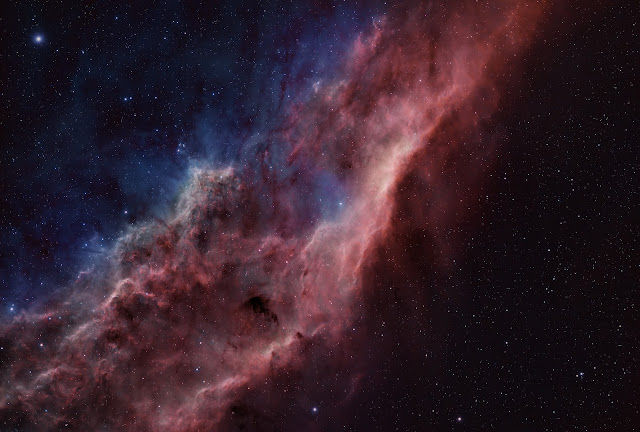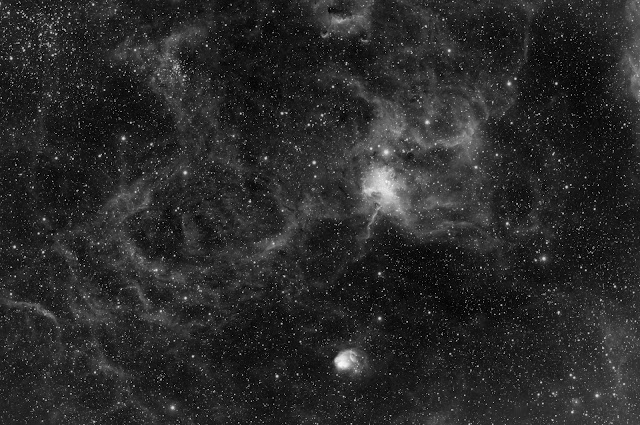A reprocess of the data now using the drizzled data. I love it.
Saturday 22 April 2023
Wednesday 19 April 2023
M88 & M91
It has been a very windy day today, bright and clear but very windy, I wasn't hopeful looking at the weather app today for anything useful tonight. However image capture started at around 21.15 tonight with just a little wind and possibly the odd swirl inside the dome as guiding tonight is around and just under 1.00 arc second, happy with that of course but higher than the usual numbers. Looking at the subs appear every 5 minutes on the tablet, each one battered with satellites. At least I don't have to bin the subs anymore I wouldn't have anything after the first hour.
3 Hour RGB integration
- Total Exposure: 3 Hours, 12 x 5 Minutes RGB Filters per filter
- Telescope: Altair Astro EDT130 Triplet.
- Image Acquisition: ZWO ASIair Pro
- Camera Settings: ZWO ASI2600mm pro Gain 100, 0°C
- Accessories: ZWO 7 position Filter wheel
- Optolong Broadband filters
- ZWO EAF
- Calibration Frames: Darks, Flats calibrated.
- Stacking and Processing: Pixinsight & touch ups in Photoshop.
- Size: 1d 47' 22.2" x 1d 11' 18.0"
- Pixel Scale: 1.046 arcsec/pixel
Sunday 16 April 2023
M5
A reprocess of the M5 data using drizzle, still unsure if I am happy with the difference.
Discovered in 1702, M5 by German astronomer Gottfried Kirch whilst observing a comet, M5 is very nearly a naked eye object, I cannot confess to observing it naked eye myself but visually through a telescope a stunning object. Though the camera even more spectacular resolving stars all the way to the core. Combined as a RGB image displays a wealth bright colourful stars. M5 contains a large number of Cepheid variable stars that have allowed astronomers to accurately to 24,500 light years.
- Total Exposure: 1 Hour, 30 Minutes ( 30 x 60 sec in the R,G & B filters)
- Telescope: Altair Astro EDT130 Triplet.
- Image Acquisition: ZWO ASIair Pro
- Camera Settings: ZWO ASI2600mm pro Gain 100, 0°C
- Accessories: ZWO 7 position Filter wheel
- ZWO Broadband filters
- ZWO EAF
- Calibration Frames: Darks, Flats calibrated.
- Stacking and Processing: Pixinsight & touch ups in Photoshop.
- Size: 44 x 33 arc minutes
- Pixel Scale: 1.05 arcsec/pixel
Monday 10 April 2023
Spider Nebula (update)
Started in December last year with some lovely 5h 50m of Ha data, I have managed to capture some Oiii & Sii data as well during January. 4 hours from each filter will give me a total of 11hrs 50 minutes to produce an SHO image. A JPEG of each processed image. Looking at them now I have done a star reduction on the Ha.
Ha
Combined data
Also a starless version just because I love the way it looks.
Photo Details
- Total Exposure: 11 Hours, 50 Minutes ( 46 x 300 sec Ha, 48 x 300 sec Oii, 48 x 300 sec Oiii Frames)
- Telescope: Skywatcher Esprit ED100
- Image Acquisition: ZWO ASIair Pro
- Camera Settings: ZWO ASI2600mm pro Gain 100, 0°C
- Accessories: ZWO 7 position Filter wheel
- Optolong narrowand filters
- ZWO EAF
- Calibration Frames: Darks, Flats calibrated.
- Stacking and Processing: Pixinsight & touch ups in Photoshop.
- Size: 2.26 x 1.38 deg
- Pixel Scale: 1.41 arcsec/pixel
Friday 7 April 2023
Stephans Quintet.
A project started at the end of October last year with my now sold 100mm scope, and will be finished this year with the new 130mm. NGC 7331 and Stephan’s quintet are a fascinating group of targets. This is a huge crop of the original image(a) now just less than one by half a degree at a pixel scale of 1.44 arc sec per pixel(b).

The
enigmatic galaxy at the top is NGC 7331 a wonderful example of a spiral galaxy
located some 40 million light years away in the constellation of Andromeda. The
half a dozen smaller galaxies behind are a good deal further away at on average
of 350 million light years distance. The light you see here left when Earth was
in the Paleozoic era when Amphibians left the water to first roam the land. A
time long, long, long before the dinosaurs emerged, lived and perished.
However,
the objects of interest that inspired this image are located below. A visual
group of 5 interacting galaxies known as Stephan’s Quintet. 4 of which are
interacting with each other 270 million light years away and one NGC 7320 that
is in the foreground at just 40 million light years.
The image you see here is a composite exposure of just one hour using the green filter on the mono camera. The idea is to capture data in the Red, Green & Blue filters to produce a full colour image. This is programmed ready in the Autumn when the constellation rises again in the East.
The Little red box on the sky map is the field of view for my old telescope. The new scope will have a smaller box giving higher magnification. I hope it gives you an idea of how small these objects are.
Wednesday 5 April 2023
M3
First discovered in Dec 1764 by French astronomer Charles Messier, M3 is again a globular cluster with over 500,000 stars and an age of a mind blowing 11.4 Billion years old. Easily visible in binoculars or a telescope.
12 x 2 minute exposures in RGB channels combined in Pixinsight. Core Brightness reduction in Photoshop.
Tuesday 4 April 2023
M53
M53 is
one of about 250 globular clusters belonging to our Milky Way galaxy. At a
distance of 60,000 light years, M53 is one of the more distant clusters. The
globular contains many older red stars, but it also has a number of blue stars.
Such young blue stars are fairly uncommon in globular clusters.
One atypical feature of this image is that I
collected all of the sub exposures for this image when the Moon was89% full. Usually
I don't photograph Broadband targets when the Moon is out, as the bright light
from the Moon washes out the faint parts of most images. However, I was able to
capture this image fairly well, because globular clusters consist entirely of
stars. Almost all of the stars are individually brighter than the background
light from the Moon.
Image
capture was 12 x 3 minute exposures in the RGB filters and Pixinsight
processed.
In the same field of view from the full frame NGC5053 is a much fainter cluster of stars a little closer at 57,000 light years, very faint tidal streams suggest some interaction between the two in the past.
Sunday 2 April 2023
A galaxy and an asteroid.
I don't think I have attempted to capture Ceres before but here we have it by chance as I put the new scope through it's paces on galaxy season. I was going to continue with my M95 project previously posted when I scrolled around Stellarium to see Ceres placed in the frame with M100. After a few lunar captures earlier I set an autorun for a few hours of data. Having a few calibration frame issues with the Flats not working properly, had a similar issue last year but a new set of flats with a higher ADU value solved the problem.
So here we have a massive crop of the original frame to show the beautiful M100 in all it's spiral glory.
A few details on Ceres.
The largest of the catalogued asteroids at just under a 1000km in diameter, Ceres roams the solar system at an average distance of 400 million Km's. Ceres was discovered in 1801 after the prediction of another body between Mars & Jupiter.
California Nebula
NGC1499 The California Nebula. Discovered in 1889 The California Nebula is an emission nebula in the constellation of Perseus, currently v...

-
Object: M45Type: Open Cluster Distance: 380Light Years (Approx) Constellation: Taurus Date : 27th October 08 Equipment: William Optics M...
-
Without doubt the finest of globular clusters visible in the northern hemisphere. Located outside the plane of our galaxy and some 25,000 li...


























